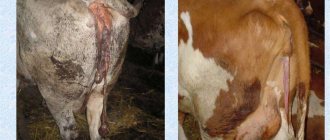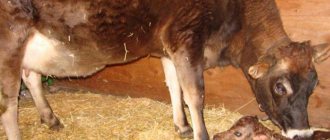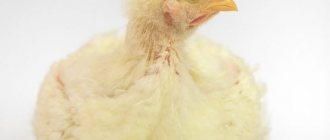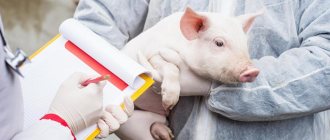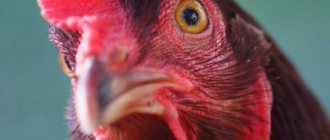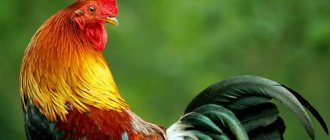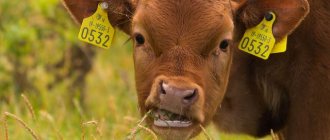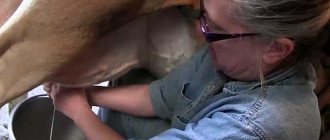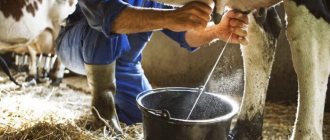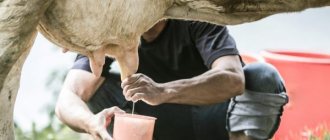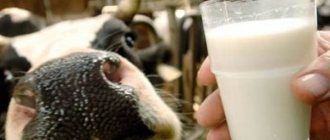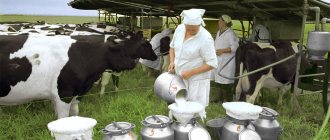The structure of the stomach and the mechanism of chewing gum
The stomach of ruminants has an unusual structure. It consists of four departments:
- Scar.
- Grids.
- Books.
- Abomasum.
The food cows eat travels down the esophagus into the rumen. After some time (half an hour to an hour after eating), thanks to the reflex contraction of the forestomach, which is controlled by the vagus nerve, the cow regurgitates a portion of food from the rumen back into the oral cavity. The cow carefully processes the food and moistens it with saliva, and after about a minute swallows it again.
https://www.youtube.com/watch?v=subscribe_widget
When the chewing stops, there is a short period of rest, after which everything repeats. During the day, a cow can process up to 60 kilograms of feed contained in the rumen. The food chewed and moistened with saliva, returning to the stomach, is mixed with the rest of the contents of the rumen and gradually moves towards the abomasum through the mesh and book, thanks to regular contractions of the proventriculus muscles. If a cow does not chew cud, this indicates a malfunction of the digestive system. There are several reasons why this could happen.
The calf’s stomach is designed according to the same principle - it has 4 chambers, but while the baby feeds on mother’s milk, only one of them is used - the abomasum. Milk enters there directly from the esophagus and is absorbed in full. This is why calves don't chew cud. All parts of their stomach begin to work a few weeks after birth, when calves are introduced to complementary feeding made from hay.
Arrangement of the digestive system of cattle
Feed characteristics
Like any other animal, a cow needs a varied and balanced diet that will provide the body with the necessary elements to ensure good health and high productivity. First of all, we are talking about the balance of basic and concentrated feeds.
The cow's menu must include rough, juicy, green feed and concentrates.
Did you know? Several miniature breeds of cows were bred in the world, which did not exceed 1 m at the withers. One of them appeared in Africa - representatives of the Shorthorn breed had a height of 80–100 cm and a weight of 150–200 kg. In Mexico, one farmer bred a cow that reached a height of 62 cm and produced a liter of milk per day.
Rough
Rough feeds include hay and straw. Every day a dairy cow needs up to 4–5 kg of roughage - this figure depends on the time of year, the amount of milk produced and the presence of other types of feed in the diet. For meat breeds, roughage products should make up 30% of the total diet.
These products are vital for cattle, as they saturate the body with protein, fiber, vitamins, calcium and phosphorus. And this, in turn, has a positive effect on the functioning of the digestive tract, metabolic processes, productivity, general well-being and weight gain.
The nutritional characteristics of hay depend on what plants it was prepared from and under what conditions it was stored. Dried cereals and legumes are considered the healthiest.
If the cow does not have enough hay, then straw is introduced into the diet. It contains a sufficient amount of fiber, but little plant protein and no minerals and vitamins.
Straw made from winter crops is prepared in a special way before feeding, since it is too hard. Straw from barley and oats is given as feed without preparation.
Important! If poisonous and thorny herbs get into the hay, its quality is significantly reduced: such feed can lead to poisoning of animals. Also, intoxication is caused by hay that was stored incorrectly - in conditions of high humidity and lack of air ventilation.
Greens
The main diet of cattle must include fresh grass. Adults can consume up to 70 kg of grass per day.
Green food contains proteins, amino acids, vitamins, and minerals necessary for the normal functioning of the animal’s body. However, their main advantage is that they are perfectly absorbed by the cow's digestive system. Young meadow grasses with an admixture of legumes are considered the most valuable and highly nutritious green food.
Juicy
The succulent feed that cows are given is silage (from corn and sunflower), haylage (a mixture of annual and perennial grasses with legumes), root and tuber crops (potatoes, beets, carrots) and melons (watermelons, pumpkin). This type of food is required in winter. It allows you to maintain a high level of milk yield, maintain a strong immune system, replenish water deficiencies, and improve the digestibility of other types of feed. Haylage also replenishes sugar and carotene reserves.
The recommended amount of succulent feed in the cattle diet is 4–5 kg per day.
Concentrated
Concentrated feed includes grain crops, production waste (cake, meal, bran, pulp, flour), as well as mixed feed. They are highly nutritious and are indispensable when preparing the diet of cows that require good milk yield or meat yield.
For dairy cows, the following concentrate consumption standards exist:
- with a daily milk yield of 10–15 kg - 100–150 g for each kg of live weight;
- with a milk yield of 15–20 kg – 150–200 g/kg;
- with a milk yield of 20–30 kg – 200–300 g/kg.
The amount of such products will depend on the focus of the animal, the need for phosphorus and proteins. However, it is impossible to completely build a diet on concentrates alone.
We suggest you familiarize yourself with How to clean an electric kettle: 7 ways to clean the device inside and out from rust and scale
The cow eats poorly or not at all
There are so many reasons why a cow refuses food that even an experienced farmer will not always be able to immediately figure out what’s going on. Lack of appetite can be caused by either a sudden change in diet or more serious problems. There are a number of main reasons that are worth studying carefully.
Metabolic disorders in the body
Disruption of metabolic processes in an animal’s body is most often a consequence of an existing problem, and not an independent factor in decreased appetite (for example, a similar phenomenon is observed with ketosis).
However, there are cases when metabolic disorders are caused by improper actions of the farmer himself, who gives the cows a lot of protein-rich feed. In addition, a disorder of normal metabolism can be a consequence of regular use of low-quality food or irregular feeding of cattle.
Clinical symptoms of metabolic disorders will depend on several factors:
- the amount of ketone bodies contained in the blood;
- reducing glucose levels and alkaline blood deficiency;
- disruption of the normal functioning of internal organs.
If such disorders are not corrected in time, the animal will quickly lose its attractive appearance (dermatitis and hair loss are often observed) and milk yield will decrease, more frequent diarrhea will quickly be replaced by constipation, skin elasticity will decrease, and the liver will enlarge.
Unsanitary conditions
Unsanitary conditions in the barn often become the main cause of the development of many diseases, especially gastrointestinal infections.
Of course, if there is any malfunction in the body or any painful manifestations, the animal will refuse to eat.
In addition, some cows simply do not want to eat dirty and crushed feed, so all food should only be fresh, and the barn must be put in order.
A sudden change in diet
The cow's body very quickly gets used to the prepared diet, adapting to it all the processes occurring inside. Therefore, the sudden introduction of a new product can cause prolonged diarrhea, which in turn will negatively affect the general condition of the cow.
Any change in the cattle menu should be smooth, carried out over 1–2 weeks.
Read also: How to save a cow from milk stone disease?
Overeating or poisoning
A deterioration in the cow’s condition caused by overeating or poisoning can also serve as a reason for refusing food. In the first case, a long walk in the fresh air will help alleviate the cow’s suffering, and in the second, medical intervention may be required using drugs to normalize the functioning of the stomach.
Poisoning with chemical compounds also requires detoxification of the body, for which special medications are also used.
To prevent such problems, before distributing food to animals, you need to make sure that it is of high quality and free of mold and other signs of spoilage.
Foreign objects entering the cow's stomach
Caring and responsible owners should always inspect the pasture before grazing cows to eliminate the possibility of foreign objects. However, even in this case, there is no guarantee that the animal will not find a rusty nail, piece of glass or wire in the tall grass.
Any of these objects, entering the digestive system, easily injures the mucous membranes, as a result of which the cow becomes lethargic, stops eating and reduces milk yield. Chewing gum may be completely absent or very weak.
Postpartum, prenatal paresis
During the prenatal and postpartum period, the cow needs especially careful treatment from the owner. This means that the conditions of housing, grazing and nutrition must be at the highest level, since the likelihood of digestive disorders is now very, very high. In addition to this, the possibility of developing prenatal and postpartum paresis should not be ruled out. Basically, this disease manifests itself in cows immediately after calving and the reasons for its occurrence are still unclear. Sick animals experience paralysis of the limbs, tongue, larynx and disruption of digestive processes, which is the reason for refusing food.
Worm infestation in cattle is one of the main reasons for sudden weight loss, depression and refusal to eat. In some cases, animals experience constipation (or vice versa, diarrhea), and as the condition worsens, anemia develops.
Often the mucous membranes turn pale, and the coat begins to roll and loses its usual shine.
This word refers to an animal disease characterized by an increase in ketone bodies in their blood, with a simultaneous disruption of carbohydrate, protein and fat metabolic processes. One of the possible reasons for the development of ketosis may be calcium deficiency, which is why the cow not only eats poorly, but also reduces milk yield.
The disease can be identified by the following characteristic symptoms:
- sudden refusal of food;
- decreased milk supply;
- the appearance of apathy and lethargy;
- refusal of water or its large consumption;
- lack of chewing gum.
A cow with ketosis quickly loses weight and looks weak and emaciated. Sometimes animals become nervous and restless, and after calving they even refuse to feed the calf and begin to eat inedible things. If not treated in a timely manner, ketosis leads to irreversible consequences in the body.
Tympany of the rumen
Rumen tympany is an acute or chronic condition manifested by protrusion of the left side, tension in the hungry pit and general restlessness of the cow.
Rumen tympany can be an independent ailment caused by indigestion, or it can be a consequence of other pathological factors: for example, blockage of the esophagus or pharynx.
In both cases, the animal refuses food, becomes restless, often lies down, and when it gets up, it can hit itself in the stomach with its hooves. In this case, rapid and shallow breathing is observed, and the number of heart contractions increases significantly.
The expansion of scar chambers under the influence of gases accumulated in them leads to compression of other organs and disruption of blood flow, which is why the disease requires immediate medical intervention.
Causes of digestive system failure
So, the absence of chewing gum is a symptom that cannot be ignored; it indicates a malfunction of the cow’s digestive system. Let's look at the main reasons for loss of cud in calves:
- Atony.
- Tympany.
- Traumatic reticulitis.
Each of these conditions is dangerous for the cow. In the process of getting to know these diseases, it will become clear why.
Atony
A decrease in the contractility of the stomach or its complete absence is called atony. If the muscles of the proventriculus stop contracting, the food in the rumen stagnates and the digestion process stops. This condition poses a threat to the cow - intestinal obstruction and tympany, that is, bloating, may develop. Reasons for stopping the motor activity of the stomach:
- A sharp change in the diet of calves.
- Poor quality feed, for example, hay or grain affected by mold fungi.
- Eating large amounts of succulent feed or concentrates.
- Drinking poor quality water.
- Lack of exercise.
Treatment of atony is aimed at resuming gastric motor activity and preventing gas formation. During the first day, the calf should be kept on a starvation diet, and drinking should not be limited. Massage helps increase the tone of the proventriculus muscles. It is performed with a fist on the outer part of the peritoneum in the area of the hungry fossa.
Sodium chloride
Sodium chloride is administered intravenously. Already after a single injection, the contractility of the proventriculus is noticeably enhanced.
Tympany
Swelling of the scar is called tympania. Increased gas formation can occur as a result of blockage of the esophagus, gastric atony, and predisposing factors are:
- Eating easily fermented feed.
- Excessive feeding of concentrates.
- Cow eating poisonous plants.
Tympany is life-threatening for the calf. Gases accumulating in the rumen increase the volume of the stomach, resulting in pressure on the diaphragm. The cow suffers from a lack of oxygen. If you don't help her in time, death from asphyxia will occur.
Treatment of tympany is carried out urgently if there are signs of oxygen starvation - blue mucous membranes, shallow breathing. In this case, the scar is punctured with a trocar. In other cases, massage the hungry pit and pouring cold water over this area is used.
To stimulate the passage of gases, the cow is positioned so that the front part of the body is higher than the back. If necessary, use a probe. It makes it easier to remove gases from the rumen. The following remedies help reduce the concentration of gases in the rumen:
- Ichthyol solution.
- Magnesia.
- Ammonia solution.
- New milk.
Magnesia
The cow is kept on a starvation diet for a day, after which the usual feed is gradually introduced into the diet.
If a cow does not chew the cud, it is possible that she has traumatic reticulitis. This disease occurs when an animal swallows sharp objects and they injure and sometimes perforate the rumen wall. In this case, the stomach also stops working, and then tympany occurs. The foreign body that caused the loss of gum must be removed.
Now you know, if a cow doesn't have any cud, it means her stomach is stuck or not working properly. The reasons for the failure may be:
- swelling of the scar (tympany);
- loss of tone of the rumen, mesh and abomasum (atony);
- ingestion of inedible objects (traumatic reticulitis);
- pressure of the fetus (in a pregnant cow) on the digestive organs.
Timping can occur when animals chew too much cabbage, corn or legume grass, especially after rain. This food can ferment in the cow’s stomach. The formation of a large amount of gases clogs the passages for the normal movement of food. As a result, the digestion process is disrupted and the cow does not chew.
Only a doctor can accurately determine tympany. On his own, the farmer can only assume its occurrence, noticing that the animal does not eat, does not drink, has lost its chewing gum, hits its stomach with its hind legs and looks back at it. A stuck stomach can lead to the death of the cow, so a veterinarian is needed urgently to release the accumulated gases in a suitable manner. This can be puncture of the scar or probing, as well as the use of turpentine or milk to wash the insides.
Causes of decreased or lack of appetite in cattle
If a cow has a reduced or completely absent appetite, there are many different reasons. Most often, cows refuse feed due to calcium deficiency in the body, which leads to the development of a disease such as ketosis. Note that calcium, other vital minerals, and vitamins are excreted from the body of dairy cows along with milk during milking.
In ketosis, carbohydrate and calcium metabolism and general metabolism in the animal body are disrupted. In this case, the cow not only eats poorly, but also produces little milk. Typically, this disease develops in cows 3–6 weeks after the birth of a calf. You can tell that a cow is in ketosis by the following signs:
- the cow suddenly stops eating;
- Milk yield is noticeably reduced, the cow produces less milk;
- the animal becomes apathetic, lethargic;
- the cow refuses to drink or, on the contrary, greedily absorbs water;
- The cow's chewing gum disappears.
Important! Most often, ketosis is diagnosed in high-yielding, highly productive cows, as well as in overfed cows.
A sick cow quickly loses weight and looks weak and emaciated. Ketosis can also be accompanied by nervous disorders. The animals behave restlessly, refuse to feed the calf after calving, and begin to eat inedible objects.
With this pathology, the body's own fats are broken down, which leads to the production of fatty acids, which are processed in the liver. With a strong increase in their concentration in the body, the liver does not have time to break them down, resulting in the appearance of ketone bodies, which harm the body of animals. In this case, the cow stops drinking and eating and quickly loses weight. If treatment is not started in time, ketosis can provoke irreversible changes in the body.
Read also: What to do if a cow kicks (beats) while milking?
Among the reasons that lead to a lack of appetite, the following can be identified:
- metabolic disorders in the body;
- poisoning caused by stale moldy feed, chemicals;
- unsanitary living conditions;
- viral, parasitic, bacterial diseases;
- low-quality, moldy feed;
- postpartum, prenatal paresis;
- binge eating;
- foreign objects entering the cow's stomach;
- violation of the regime, non-compliance with feeding rules;
- sudden change in diet;
- severe helminthic infestation.
Chronic pathologies in the gastrointestinal tract, which can develop in any part of the digestive tract of cattle, also often cause a decrease in appetite.
Why doesn't a cow eat hay and what to do about it?
Hay must be included in the cow's diet, regardless of the period. However, it happens that cows refuse to eat it. This can happen for several reasons, which are described below. We also provide methods on how you can force an animal to eat as before.
Impact of diseases
Often cattle refuse roughage if they are unwell. There are several diseases that lead to disruption of the digestive tract and a decrease or loss of hunger. In order to restore appetite and improve digestive function, it is necessary to establish the cause of the problem and eliminate it.
Some cow breeders are faced with the fact that small calves refuse to eat hay. As a result, they do not gain weight, and owners experience difficulties in selecting foods for the baby.
In order for the calf to start eating normally, you need to understand the reasons for its refusal to eat. First, it is necessary to exclude congenital pathologies, which include white muscle disease, paratyphoid fever, pneumonia, inflammation of the gastric mucosa, and hernia. To accurately determine the cause, it is necessary to show the baby without appetite to the veterinarian.
Colds are also common causes. If the calf's body temperature is elevated, it most likely has a cold and needs veterinary attention.
Another reason why a baby refuses to eat roughage is that he has only recently been fed his mother’s milk and simply does not know what hay is, what it can be eaten and how to do it. In this case, you need to wait a little for the calf to adapt to the new type of food. Accustoming calves to fresh hay begins no earlier than they reach 20 days: they do this persistently, constantly leaving it in the feeder or feeding it by hand.
We invite you to familiarize yourself with Cabbage in three days in a jar
According to the standards, at the age of 2-3 months a calf should eat about 1 kg of hay, at 4 months - 3 kg, at 5 months - 4 kg, at 6 months - 5 kg. If no health problems are identified, then the owner needs to create a diet without hay, and offer the product in question a little later, when the calf grows up.
Did you know? Usually a cow gives birth to one, maximum two calves. However, there are unique cases when females gave birth to 5 and 8 babies. And in 1939, the cow gave birth to a record number of calves in one calving - 16. But, unfortunately, only 1 of them turned out to be full-term.
Thus, there are many reasons why a cow refuses to eat. Most often this is associated with the development of a disease. To improve the functioning of the animal’s digestive system, the cause must be identified and eliminated. This task must be entrusted to a competent veterinarian.
Manifestation of ketosis
Loss of appetite and refusal to drink water can be one of the symptoms of ketosis. There was a decrease in glucose in the body. If symptoms have just begun to appear. Ketosis is treated with nutritional correction. The animal is given sugar beets, carrots, and haylage. Reduce the amount of concentrates. The cow must be given hay. She drinks sweetened water as a drink. On the forums it is advised to offer the cow to chew tea, 5-6 bags. Tea is brewed for drinking and sugar is added to it. If the animal refuses the offered food and does not drink water or tea, then it is necessary to begin complex treatment.
- “Tetravit” – intramuscularly 15 ml.
- Glucose 500 ml 30% solution is administered intravenously.
- Propylene glycol – 500 ml. The solution is poured into a plastic bottle and given to the cow to drink.
- “Sodium lactate” – 450 ml. Administered orally using a plastic bottle.
More on the topic: How to create a cow’s daily diet?
Ketosis can be determined using a rapid test. These are stripes. The strip contains a substance sensitive to ketone bodies. The strip is immersed in milk for 3 minutes. It will change color. The level of ketone bodies is determined by the saturation of the shade. Level 1-1.4 is considered dangerous.
Treatment with folk remedies
If a cow's cud has disappeared, you can try to cure it with folk remedies. Hellebore tincture helps to restart the stomach if it stops. Calves are given 10 ml of the product to drink, having previously dissolved it in half a liter of water. Adults are given 15 ml of hellebore tincture.
The following folk remedies for getting the stomach started will be no less effective:
- Cucumber pickle.
- Mineral water.
- Lactic acid.
- Chamomile or St. John's wort decoction.
If you discover that your calf has lost its cud, call your veterinarian to determine the cause. The animal needs to be helped as soon as possible, especially if there are signs of oxygen deficiency, which develops with tympany. Delay may result in the loss of the animal.
If a cow chews for several hours a day almost non-stop, there is no reason to doubt her health. Rather, on the contrary, it is a sign of a good mood and complete calm that comes during relaxation. For this feature, these representatives of cattle were called ruminants. The cattle owner needs to worry when this process is absent. And if suddenly the cow does not chew the cud, we urgently need to find out the reason and take action.
Other reasons
Digestive problems are also noted with rumen tympany, which occurs due to blockage of the esophagus, accumulation of gases or due to overeating, when eating moldy hay, frozen feed, or wet grass. This pathology can also be provoked by eating a large number of root vegetables, an excess of protein supplements and premixes in the diet. If cows eat such feed, the load on the cow’s stomach, in particular, on the rumen, increases.
Digestive problems also arise against the background of rumen atony. This pathology is associated with incorrect, impaired contraction of the preventricles and is characterized by a lack of chewing gum, a depressed state, and a complete refusal of food and water. The cow loses weight, becomes lethargic, and does not give milk. With rumen atony, all digestive processes stop, and if timely assistance is not provided, they can cause the death of the cow.
Traumatic reticulitis in cattle is caused by eating hay that contains foreign objects (metal nails, glass, wire). Getting into the gastrointestinal tract of animals, they injure the mucous membrane of the digestive organs. The disease manifests itself as general malaise, weakness, lethargy, and apathy. The chewing gum is weak or completely absent. With this pathology, the cow does not eat or drink, and does not produce milk.
First he swallows, then he chews
People have raised cattle for many centuries. They observed and gradually learned the digestive system of animals that chewed constantly. It turned out that the cow's stomach is very complex. There is a version that the formation of this organ was influenced by evolution over many thousands of years.
The wild cow, unable to fend for itself, quickly grabbed food, swallowed it, and hid from predators in a secluded place. And only then did she begin to chew, as if while resting. At first glance, it is not clear how one can first swallow and then chew. However, the danger of a situation when a cow suddenly loses its cud becomes clear if we take the process apart.
The sections of the stomach have the following names:
- scar;
- net;
- book;
- abomasum.
To understand why there are so many of them, you need to analyze the function of each, plus consider the work of the intestines as an important organ of the digestive tract. Only then can you clearly imagine what happens to a cow chewing for several hours a day.
Chewing gum formation
If a cow, for example, eats grass, then the greens enter the rumen through the esophagus - this is the first section of the stomach (forestomach). Fermentation of consumed products occurs here, that is, they are already slightly processed.
This is the largest part of the stomach; the capacity can reach 200 liters in an adult cow. In a normally developed calf, the rumen makes up 80% of the total volume of all sections. You can read about how a baby eats, why he loses his appetite and, in general, about gastric processes in young cattle in the article “How to treat a calf if it has lost its cud.”
The second compartment where food goes is called the mesh. Through it, the crushed products pass further along the tract. And then the chewing gum itself is formed, in the form of balls. In these first two sections, fermentation occurs, that is, after the breakdown of carbohydrates, fatty acids (volatile) are formed. The appearance of gases in the stomach, one of which is high-energy methane, contributes to belching.
Porridge is cooked in a book
Large pieces of food (balls) cannot pass through the mesh, and during regurgitation they fall back into the mouth through the esophagus. Scientifically, this phenomenon is called rumination. Actually, then the process of chewing cud in a cow begins. She eats, working hard with her jaws, until the food is completely chewed. At the same time, small pieces pass into the third section of the stomach, called the book.
This part of the digestive organ received this name due to the presence of sheets similar to book pages. They have a coarse horny composition, which helps grind any food into pulp.
Then the resulting mass passes into the abomasum - this is the last, but no less important section of the stomach. It has a glandular structure. In it, all food is processed by gastric juice, and proteins are absorbed. After which all the contents are sent to the intestines, where the remaining enzymes are absorbed into the blood.
